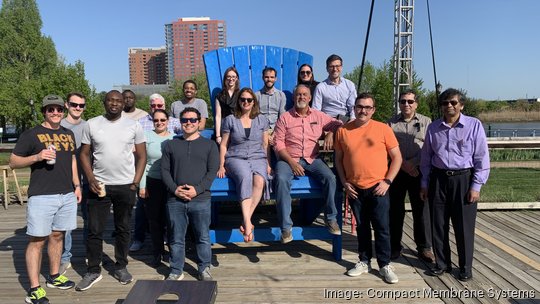
Compact Membrane Solutions, a Wilmington startup working on carbon capture technology for heavy industry, has raised an oversubscribed $16.5 million Series A round.
The round was led by Pangaea Ventures, with participation from GC Ventures, Solvay Ventures, Chevron Technology Ventures and Technip Energies. The oversubscribed round is the company’s first venture capital raise after securing several federal grants totaling $60 million in its over 20 years in existence. The fundraising will primarily go toward research and development of Compact Membrane Solutions’ carbon capture technology, a bolt-on option aimed at reducing emissions from hard-to-abate industries like steel and cement manufacturing.
Heavy industry as a whole is responsible for some 40% of global carbon dioxide emissions, and there isn’t a clearcut method for manufacturers to reduce their carbon footprint, said CEO Erica Nemser said.
“This is the unlock for that piece, they’re lagging,” Nemser said. “There isn’t a large scale pathway that they have right now in the way that you can go out and buy an [electric vehicle] or go get solar panels on your house. This is bringing in movement to heavy industry to go after that that third of emissions that represents gigatons of CO2.”
The company’s technology uses membranes to capture and separate carbon dioxide rather than letting it release into the atmosphere. Compact Membrane Systems launched a pilot for a similar technology, which captures olefins, at chemical company Braskem’s facility in Marcus Hook last April.
The fresh funding will help accelerate the timeline to get the carbon capture technology to the pilot stage and allow the company to “push full speed ahead in both research and development,” COO William Charlton said.
“Having this funding really enables us to move down the road much quicker than we could have prior to this,” Charlton said. “It gives us the opportunity to build our team, bring in the technical resources and the commercial resources that we need to enable us to really pursue this at a heightened pace than where we would have been a year or two ago.”
Charlton and Nemser said that three smaller scale pilots for the carbon capture technology are on track to go into the field next year. Charlton hopes to have the technology working on a commercial plant in the next four to five years. The cost to a commercial facility to install the carbon capture technology is $50 per ton of carbon emitted, Nemser said. On average, every ton of steel produced 1.89 tons of carbon dioxide in 2020, according to the World Steel Association. Nemser said that utilizing the company’s carbon capture technology would increase the cost of a project by 1% to 3%.
“For the world and the future, if you really want to do very low cost CO2 capture and you really want to help the world reduce CO2 emissions and you want to do that quickly and you want to do that soon, you want to do it with the existing infrastructure,” Nemser said. “It has to be low cost, it has to be low energy and that’s what this solution enables us to do.”
Compact Membrane Systems has a team of 23 and is looking to grow to over 30 in the next several months, said Nemser, adding that over the course of two years she hopes to double headcount. She said the company typically will “lean into the local ecosystem” in its hiring, sourcing talent from Philadelphia-area universities.
Nemser came to the company nine years ago, joining a team of scientists and tasked with running business operations after spending nearly 14 years in management consulting with McKinsey and Co. She holds a master’s and doctorate in economics from the University of Pennsylvania. Charlton, with an engineering degree from Drexel and MBA from Villanova, spent close to 22 years with Sunoco in operations.
Backed by the new funding, Nemser and Charlton have major aspirations to have a long-lasting impact on climate change.
“In five to 10 years we [will be] actively pulling gigatons of CO2 out of the atmosphere and enabling folks to buy green steel, green cement, green hydrogen and are embedded in the way that industry is addressing the climate challenge,” Nemser projects.
Original Publish: https://www.bizjournals.com/philadelphia/inno/stories/fundings/2023/08/02/wilmington-climatetech-startup-carbon-membrane.html

